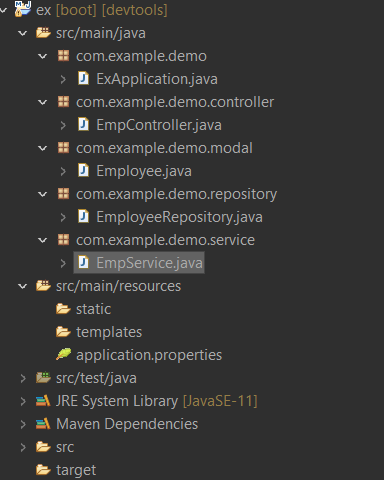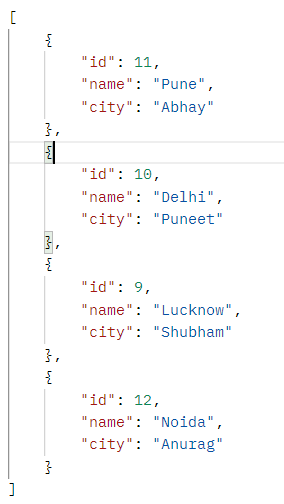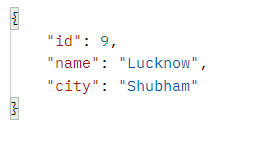August 28, 2024
Summary: in this tutorial, we will see how to integrate Spring Data JPA with PostgreSQL.
What is Spring Boot?
Spring Boot is an open-source Java framework used to create a Micro Service. Spring boot provides a faster and an easier way to set up, configure, and run both simple and web-based applications. It is a combination of Spring Framework and Embedded Servers. The main goal of Spring Boot is to reduce development, unit test, and integration test time and in Spring Boot, there is no requirement for XML configuration.
What is Spring Data JPA?
Spring Data JPA or JPA stands for Java Persistence API, so before looking into that, we must know about ORM (Object Relation Mapping). So Object relation mapping is simply the process of persisting any java object directly into a database table. Usually, the name of the object being persisted becomes the name of the table, and each field within that object becomes a column. With the table setup, each row corresponds to a record in the application. Hibernate is one example of ORM. In short, JPA is the interface while hibernate is the implementation.
The java persistence API provides a specification for persisting, reading, and managing data from your java object to your relational tables in the database. JPA specifies the set of rules and guidelines for developing interfaces that follow standards. Straight to the point: JPA is just guidelines to implement ORM and there is no underlying code for the implementation. Spring Data JPA is part of the spring framework. The goal of spring data repository abstraction is to significantly reduce the amount of boilerplate code required to implement a data access layer for various persistence stores. Spring Data JPA is not a JPA provider, it is a library/framework that adds an extra layer of abstraction on the top of our JPA provider line Hibernate.
Configure Spring Data JPA in Spring Application with Example
Requirements: Spring Tool Suite IDE, Java 8+
Create a spring boot project in spring tool suite. Give project name & select add required dependencies(Spring JPA, PostgreSQL driver, Spring web) shown in attached pom.xml.
<?xml version="1.0" encoding="UTF-8"?>
<project xmlns="http://maven.apache.org/POM/4.0.0" xmlns:xsi="http://www.w3.org/2001/XMLSchema-instance"
xsi:schemaLocation="http://maven.apache.org/POM/4.0.0 https://maven.apache.org/xsd/maven-4.0.0.xsd">
<modelVersion>4.0.0</modelVersion>
<parent>
<groupId>org.springframework.boot</groupId>
<artifactId>spring-boot-starter-parent</artifactId>
<version>2.6.1</version>
<relativePath/> <!-- lookup parent from repository -->
</parent>
<groupId>com.example</groupId>
<artifactId>ex</artifactId>
<version>0.0.1-SNAPSHOT</version>
<name>ex</name>
<description>Demo project for Spring Boot</description>
<properties>
<java.version>11</java.version>
</properties>
<dependencies>
<dependency>
<groupId>org.springframework.boot</groupId>
<artifactId>spring-boot-starter-data-jpa</artifactId>
</dependency>
<dependency>
<groupId>org.springframework.boot</groupId>
<artifactId>spring-boot-starter-web</artifactId>
</dependency>
<dependency>
<groupId>org.springframework.boot</groupId>
<artifactId>spring-boot-devtools</artifactId>
<scope>runtime</scope>
<optional>true</optional>
</dependency>
<dependency>
<groupId>org.postgresql</groupId>
<artifactId>postgresql</artifactId>
<scope>runtime</scope>
</dependency>
<dependency>
<groupId>org.springframework.boot</groupId>
<artifactId>spring-boot-starter-test</artifactId>
<scope>test</scope>
</dependency>
</dependencies>
<build>
<plugins>
<plugin>
<groupId>org.springframework.boot</groupId>
<artifactId>spring-boot-maven-plugin</artifactId>
</plugin>
</plugins>
</build>
</project>
OR you can also add these dependencies while creating the project.
application.properties file:
spring.datasource.url=jdbc:postgresql://localhost:5432/emp
spring.datasource.username=postgres
spring.datasource.password=postgres
spring.datasource.driver-class-name=org.postgresql.Driver
spring.jpa.database-platform = org.hibernate.dialect.PostgreSQLDialect
spring.jpa.generate-ddl=true
spring.jpa.hibernate.ddl-auto = update
Project Structure:

Modal layer:
Create a simple POJO(Plain old java class) with some JPA annotation.
- @Entity: This annotation defines that a class can be mapped to a table.
- @Id: This annotation specifies the primary key of the entity.
- @GeneratedValue: This annotation is used to specify the primary key generation strategy to use. i.e. Instructs database to generate a value for this field automatically. If the strategy is not specified by default AUTO will be used.
package com.example.demo.modal;
import javax.persistence.Entity;
import javax.persistence.GeneratedValue;
import javax.persistence.GenerationType;
import javax.persistence.Id;
// @Entity annotation defines that a
// class can be mapped to a table
@Entity
public class Employee {
// @ID This annotation specifies
// the primary key of the entity.
@Id
// @GeneratedValue This annotation
// is used to specify the primary
// key generation strategy to use
@GeneratedValue(strategy = GenerationType.AUTO)
private long id;
private String name;
private String city;
public Employee() {
super();
}
public Employee(String name, String city) {
super();
this.name = name;
this.city = city;
}
public String getName() {
return name;
}
public void setName(String name) {
this.name = name;
}
public String getCity() {
return city;
}
public void setCity(String city) {
this.city = city;
}
}
DAO(Data access object) layer:
- @Repository: The @Repository annotation is a marker for any class that fulfills the role or stereotype of a repository (also known as Data Access Object or DAO).
- JpaRepository<Employee, Long> JpaRepository is a JPA-specific extension of the Repository. It contains the full API of CrudRepository and PagingAndSortingRepository. So it contains API for basic CRUD operations and also API for pagination and sorting. Here we enable database operations for Employees.
package com.example.demo.repository;
import org.springframework.data.jpa.repository.JpaRepository;
import org.springframework.stereotype.Repository;
import com.example.demo.modal.Employee;
// @Repository is a Spring annotation that
// indicates that the decorated class is a repository.
@Repository
public interface EmployeeRepository extends JpaRepository<Employee, Long> {
ArrayList<Employee> findAllEmployee();
}
Service layer:
package com.example.demo.service;
import java.util.ArrayList;
import com.example.demo.modal.Employee;
public interface EmpService {
ArrayList<Employee> findAllEmployee();
Employee findAllEmployeeByID(long id);
void addEmployee();
void deleteAllData();
}
@Service: This annotation is used with classes that provide some business functionalities. Spring context will autodetect these classes when annotation-based configuration and classpath scanning is used. Here JPA repository has lots of predefined generic methods to perform the database operation, some are used in the below code.
package com.example.demo.service;
import java.util.ArrayList;
import java.util.Iterator;
import java.util.Optional;
import org.springframework.beans.factory.annotation.Autowired;
import org.springframework.stereotype.Service;
import com.example.demo.modal.Employee;
import com.example.demo.repository.EmployeeRepository;
// @Service marks a Java class that performs some service,
// such as executing business logic, performing
// calculations, and calling external APIs.
@Service
public class EmpServiceImpl implements EmpService {
@Autowired
EmployeeRepository employeeRepository;
@Override
public ArrayList<Employee> findAllEmployee() {
return (ArrayList<Employee>) employeeRepository.findAll();
}
@Override
public Employee findAllEmployeeByID(long id) {
Optional<Employee> opt = employeeRepository.findById(id);
if (opt.isPresent())
return opt.get();
else
return null;
}
@Override
public void addEmployee() {
ArrayList<Employee> emp = new ArrayList<Employee>();
emp.add(new Employee("Lucknow", "Shubham"));
emp.add(new Employee("Delhi", "Puneet"));
emp.add(new Employee("Pune", "Abhay"));
emp.add(new Employee("Noida", "Anurag"));
for (Employee employee : emp) {
employeeRepository.save(employee);
}
}
@Override
public void deleteAllData() {
employeeRepository.deleteAll();
}
}
Controller layer:
- @RestController: This is a Spring annotation that is used to build REST API in a declarative way. RestController annotation is applied to a class to mark it as a request handler, and Spring will do the building and provide the RESTful web service at runtime.
- @Autowired: This annotation can be used to autowire bean on the setter method just like @Required annotation, constructor, a property, or methods with arbitrary names and/or multiple arguments.
- @PostMapping: This annotation maps HTTP POST requests onto specific handler methods. It is a composed annotation that acts as a shortcut for @RequestMapping(method = RequestMethod.POST).
- @GetMapping: This annotation is a specialized version of @RequestMapping annotation that acts as a shortcut for @RequestMapping(method = RequestMethod.GET). The @GetMapping annotated methods in the @Controller annotated classes handle the HTTP GET requests matched with the given URI expression.
- @DeleteMapping: This annotation maps HTTP DELETE requests onto specific handler methods. It is a composed annotation that acts as a shortcut for @RequestMapping(method = RequestMethod.DELETE).
package com.example.demo.controller;
import java.util.ArrayList;
import org.springframework.beans.factory.annotation.Autowired;
import org.springframework.web.bind.annotation.DeleteMapping;
import org.springframework.web.bind.annotation.GetMapping;
import org.springframework.web.bind.annotation.PathVariable;
import org.springframework.web.bind.annotation.PostMapping;
import org.springframework.web.bind.annotation.RestController;
import com.example.demo.modal.Employee;
import com.example.demo.service.EmpServiceImpl;
@RestController
public class EmpController {
@Autowired
EmpServiceImpl empServiceImpl;
@PostMapping("/")
public void add() {
empServiceImpl.addEmployee();
}
@GetMapping("/findall")
public ArrayList<Employee> getAllEmployee() {
return empServiceImpl.findAllEmployee();
}
@GetMapping("/findbyid/{id}")
public Employee getEmployeeUsingId(@PathVariable long id) {
return empServiceImpl.findAllEmployeeByID(id);
}
@DeleteMapping("/delete")
public void delete() {
empServiceImpl.deleteAllData();
}
}
Display output using JPA in postman:
Open postman and hit the listed API one by one.
Save employee data:

Find all employee list:


Find an employee by id:


Delete all employee:


